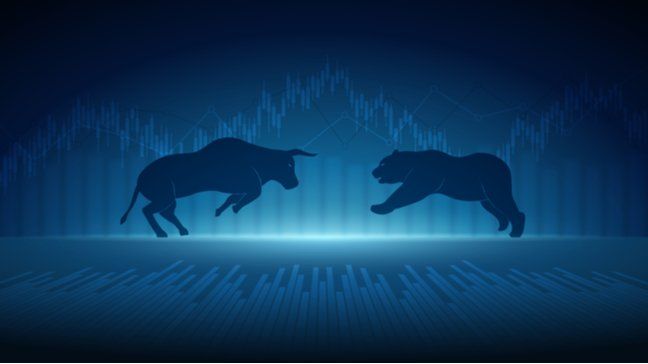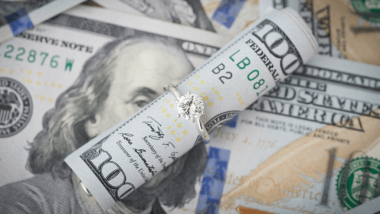“I don’t know. I feel a little bearish.”
If you hear one of your investor friends say this out of context, it might sound like he’s hungry. Or hairy. Or ready to help Leonardo DiCaprio get an Oscar in survivor.
But in the world of investing, “bearish” means something very different.
A bull or bear market is not as simple as a good or bad market. There are a few more nuances here, and once you know the key differences, you can start investing much more effectively.
What is a bear market?
If you’ve read anything about bear markets or just seen the headlines recently, you’ve probably assumed that it’s not so good. Almost like running into a bear in the forest.
Really, a bear market is when prices tend to fall.
The specific definition is when the S&P 500 stock market index drops 20% from recent highs. Looking at index prices over the past five years, I bet you can spot when we entered bearish territory:
The reason investors use the S&P 500 to identify bear markets is because the performance of the S&P 500 is widely considered to be a reflection of larger markets in general.
Now, if a bear market is an objective metric and not a feeling, why would your friend say he feels “bearish”?
In the investor world, bearish is synonymous with pessimistic.. So if your friend says that, for example, he is bearish about Tesla stock, it means that he thinks prices will start (or continue) a downtrend.
Why is the market called “bear”?
Nobody knows for sure.
Some say the term originated centuries ago, when middlemen who sold bearskins would presell them to buyers in the hope that prices would drop by the time the hunters actually brought the goods. They could presell at £10 in January, buy at £3 in May, and pocket the difference for a good product.
This is one of the theories as to how the term “bearish” came to mean the expectation of falling prices.
But others say that the terms “bear” and “bull” come from the simple fact that bears attack from below and bulls attack from above.
Are we in a bear market?
Yes, we are in a bear market right now. The S&P 500 started to decline in January 2022 and the bear market was mathematically confirmed on June 13th.
How common are bear markets?
Bear markets are quite common. On average, they occur every 56 months (four years, eight months).
What is a real estate bear market?
While the term “bear” is usually applied to the stock market, it can be applied to other markets as well.
For example, a real estate bear market is when house prices fall by 20%. And unlike the bear market in stocks that happens every four years or so, there has only been one real estate bear market in the last 20 years.
I bet you can guess when:

Source: FRED
What causes a bear market?
Many factors usually play a role in a downtrend in the markets. In 2022, these include (but are not limited to):
- Residual economic side effects of the pandemic
- Rising interest rates
- Fears of another recession
- The ongoing crypto winter
- Unexpectedly high inflation
- War in Ukraine
All of these factors make people nervous about falling markets. They create bearish sentiment, less investment, falling prices and even more bearish sentiment.
How long does a bear market last?
Historically, the average bear market has lasted nine months.
This means that the current bear market, which began in January and was confirmed in June, could start to reverse as early as October.
So what should you be doing at this time?
How to invest during a bear market
Bear markets can be an exciting investment opportunity, but like real bears, they should be approached with caution and planned carefully.
Many investors simply leave bear markets (and bears) alone. They take a “drink a pint and wait for it all to settle” approach and don’t buy or sell.
This is because they know that the markets will recover sooner or later. Centuries of historical data show us that the S&P 500 will always bounce back and make new highs. So holding on is a 100% viable strategy and you shouldn’t feel FOMO about your investment just sitting around.

Image Source: Shaun of the Dead meme. Universal Pictures.
the worst what you can do during a bear market is to sell. If you absolutely don’t need that money, leave your investment alone. Because even if your stock goes from $100 to $50, it could go up to $125 again in a few months.
Remember that red in your portfolio does not mean you have lost money. You only lose money if you don’t sell on time.
On the other hand, small, calculated purchases during a bear market can actually be a smart move. So let’s discuss strategy!
Is a bear market really a “sell-off” in stocks?
You’ve probably heard a bear market referred to as a “stock market sell-off.” There is truth in this idea, but that doesn’t mean you should go shopping right now.
The truth of this idea stems from the fact that, again, the stock market always bounces back. So, if blue-chip (also known as safe) stocks like Microsoft were worth $330 and dropped to $250, now is a good time to buy before they are likely to bounce to $330 and up.
However, here’s why many investors don’t buy during a bear market:
- We don’t know when the markets will recover. Microsoft could just as easily drop to $200 and stay there for months or years.
- … as well as if you need to sell in the meantime, you are SOL. You probably shouldn’t tie up money you may need in the near future in an unpredictable bear market.
If you want to invest safely during a bear market, consider this strategy:
1. Calculate your risk tolerance
Your risk tolerance will determine how much you can (and should) invest during a bear market. You can determine your risk tolerance by taking my 10-question multiple-choice quiz here.
One of the main risk tolerance factors will be your horizon, or how long you can afford to tie up your money. For example, if you want to buy a house in 18 months, you can play it safe by investing in a bear market.
2. Hedge your risks with dollar cost averaging
Dollar cost averaging is a fancy term for investing a little at a time. So instead of buying $1,200 worth of Microsoft today, you’re buying $100 with every monthly paycheck for a year.
DCA allows you to buy average price during the year, which helps hedge the risk of buying too high.
3. Consider index funds and savings bonds.
Index funds allow you to effectively invest in the entire stock market with a single click, which is why they are the secret to building wealth easily. You can buy them in the same way as ordinary stocks on Robin Hood or TD Ameritrade.
Treasury I savings bonds, or I bonds, offer an annual interest rate that matches the rate of inflation. So if inflation is very high during a bear market, this is a smart buy.
For example, if you invest up to $10,000 in I bonds before November 2022, you are guaranteed six months at 9.62% per annum.
Advertiser Disclosure – This advertisement contains information and materials provided by Robinhood Financial LLC and its affiliates (“Robinhood”) and MoneyUnder30, a third party not affiliated with Robinhood. All investments involve risk, and the past performance of a security or financial product does not guarantee future results or returns. Securities offered through Robinhood Financial LLC and Robinhood Securities LLC, which are members of FINRA and SIPC. MoneyUnder30 is not a member of FINRA or SIPC.”
4. Stick to Good Investing Principles
It is better not to enter a bear market (or any other market) for the purpose of short-term enrichment.
This is because it is almost impossible to determine the timing of a bear market. And just because the market is recovering doesn’t mean it will bring all stocks with it.
Good investing doesn’t change during a bear market – it just gives you the opportunity to buy a little more in a selloff. So instead of trying to find the next meme stock that will fly to the moon, it’s better to watch r/wallstreetbets from a distance and stick to the same time-tested principles of good investing:
- Know your risk tolerance
- diversify
- Keep it 90% “boring” (bonds, ETFs, index funds) and 10% “exciting” (stocks, cryptocurrencies).
Before we finish, let’s also look at bull markets. Because one day we’ll be in one!
What is a bull market?
A bull market is the opposite of a bear market. In monetary terms, this is when the S&P 500 rises 20% from recent lows.
Colloquially, the terms “bull market” or “bullish” can apply to any market, index, or individual security. You may feel bullish (or bearish) about certain stocks, the real estate market, etc.
Why is it called a bull market?
Some say the term originated on the London Stock Exchange in the nineteenth century, a full century after the bear market. At a time when traders were confident in certain stocks, they pinned them to the bulletin board – hence the bullish sentiment.
However, others say it’s simply because the bulls attack up and the bears attack down.
How long does a bull market last?
Fortunately, bull markets tend to last much longer than bear markets, with an average of 3.8 years according to Kiplinger.
Most recently, we had the longest bull market in history, from 2009 to 2020. It probably would have lasted longer too if not for this pesky pandemic!
How to invest in a bull market
Generally speaking, there are two ways that intrepid investors try to catch a bull market:
- They buy early, before prices go up.
- They sell high, to the peak of prices.
But bull market timing can be tricky. And while markets generally recover, some individual stocks may never return to their bullish peaks (see Macy’s or Norwegian Cruise Lines).
bottom line
In the end, you can skip FOMO and let bull and bear markets come and go. There is no need to rush and buy certain stocks before it is “too late”. You have plenty of time to grow your wealth, and a stable diet of index funds and random blue chips will keep your portfolio healthy no matter what the market conditions are!


